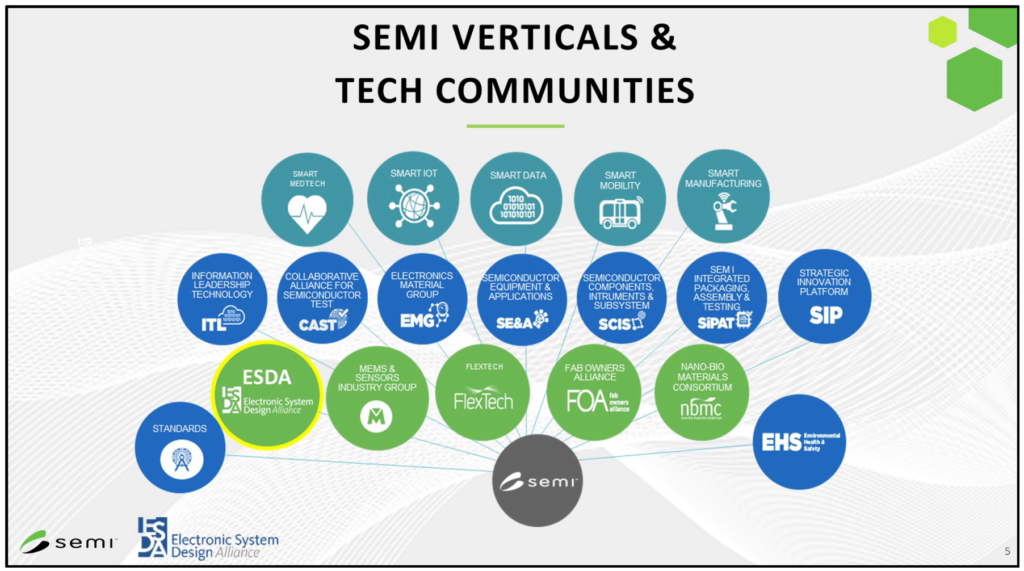As I originally reported a few weeks ago, the Jim Hogan fireside chat with Methodic’s CEO and founder Simon Butler was moved to a virtual event on May 1. The event was produced by the Electronic System Design (ESD) Alliance, a SEMI Strategic Technology Community. Bob Smith, executive director of ESDA, moderated the event. I am happy to say that the magic of a Jim Hogan fireside chat does translate to a virtual setting quite well. The event was full of good information about the ESD Alliance, the story of Methodics and a brief but compelling history of the chip design universe that got us here.
If you missed the event, don’t despair. A replay link is coming, but first a little bit about what was discussed.
Bob Smith kicked it off with some background about the ESD Alliance. This organization supports the $10B+ design ecosystem that, in turn, supports the $2T+ electronics industry. Those numbers are not a misprint; a small industry can have a major, global impact. I’ll provide one great slide Bob used that shows all the places that the ESD Alliance can help – the green circles, below.

Bob then passed the floor to Jim and Simon. Thanks to the magic of cloud-based video conferencing, we were treated to a live interaction between these gentlemen as Jim skillfully maneuvered through the events in chip design that brought Simon and Methodics to the place they are today.

The story began with Simon designing DSPs for Fujitsu in the UK and ended with Methodics creating the new category of IP Lifecycle Management. I won’t take you through the whole story – you really need to see if for yourself. There are a few people mentioned along the way that are genuine anchor tenants of the story. I’ll mention just three of them here…
After a few years in the UK, Simon came to the US and joined a company  called High Level Design Systems (HLDS). That company was subsequently acquired by Cadence while Jim Hogan was working there in the mid-1990’s. A fellow named Charlie Janac recruited Simon to HLDS and Jim to Cadence. Anyone who follows EDA or IP will have run across Charlie’s name more than once for sure. He’s the first anchor tenant of the story.
called High Level Design Systems (HLDS). That company was subsequently acquired by Cadence while Jim Hogan was working there in the mid-1990’s. A fellow named Charlie Janac recruited Simon to HLDS and Jim to Cadence. Anyone who follows EDA or IP will have run across Charlie’s name more than once for sure. He’s the first anchor tenant of the story.
After a short stint as a core comp AE at Cadence, Simon joined a company working on MIPS microprocessor cores (SandCraft). After that, Simon started a consulting business that integrated tools into the Cadence flow. A lot of that work was based on the SKILL programming language, one that’s still around today. SKILL should probably be an anchor tenant as well.
One of the projects for Simon’s growing consulting business was the development of a design data management capability for NetLogic Microsystems. Along the way, Simon realized the “service ware” he was building for NetLogic could actually be productized and sold to a broader customer base. I’ll inject a bit of my own history here. The foundation of one of my prior employers, Atrenta, followed this same path. SpyGlass was originally a custom service product that ultimately became a household name in EDA.
 Productizing a service offering only works if the customer buying the service cooperates, however. Here is where we meet the second anchor tenant of the story, Dimitrios Dimitrelis, the VP of engineering at NetLogic. Dimitrios had the foresight to allow Simon to spin out and productize the design data management capability that he built for NetLogic. And so, the foundation of Methodics was born.
Productizing a service offering only works if the customer buying the service cooperates, however. Here is where we meet the second anchor tenant of the story, Dimitrios Dimitrelis, the VP of engineering at NetLogic. Dimitrios had the foresight to allow Simon to spin out and productize the design data management capability that he built for NetLogic. And so, the foundation of Methodics was born.
After Methodics had released its initial version of Percipient (known as  “ProjectIC” at the time) and had deployed at various customers it became apparent that a new architecture would be needed to handle the scale of the larger enterprise customers that stood to benefit most from this new breed of platform, IP Lifecycle Management (IPLM). At this point, Peter Theunis was hired from Yahoo. Peter is the third anchor tenant of the story. As the new CTO, Peter’s background in systems scalability helped move the Percipient platform to the next level.
“ProjectIC” at the time) and had deployed at various customers it became apparent that a new architecture would be needed to handle the scale of the larger enterprise customers that stood to benefit most from this new breed of platform, IP Lifecycle Management (IPLM). At this point, Peter Theunis was hired from Yahoo. Peter is the third anchor tenant of the story. As the new CTO, Peter’s background in systems scalability helped move the Percipient platform to the next level.
This is clearly not the end of the story, but I’ll stop here. There’s a lot more history, insight and strategy to be learned about Methodics and how they created the IPLM category. When you view the replay, you’ll meet more anchor tenants and also experience a spirited live video Q&A with Jim and Simon. Access the webinar replay here to get the whole story. And if you’d like to learn more about membership in the Electronic System Design Alliance, you can reach out to Bob Smith at bsmith@semi.org.
Also Read:
Project-centric Design Process, or IP-centric
UPDATE: Everybody Loves a Winner
Avoiding Fines for Semiconductor IP Leakage
Share this post via:






Comments
2 Replies to “SEMI Takes the Jim Hogan and Simon Butler Conversation Virtual”
You must register or log in to view/post comments.